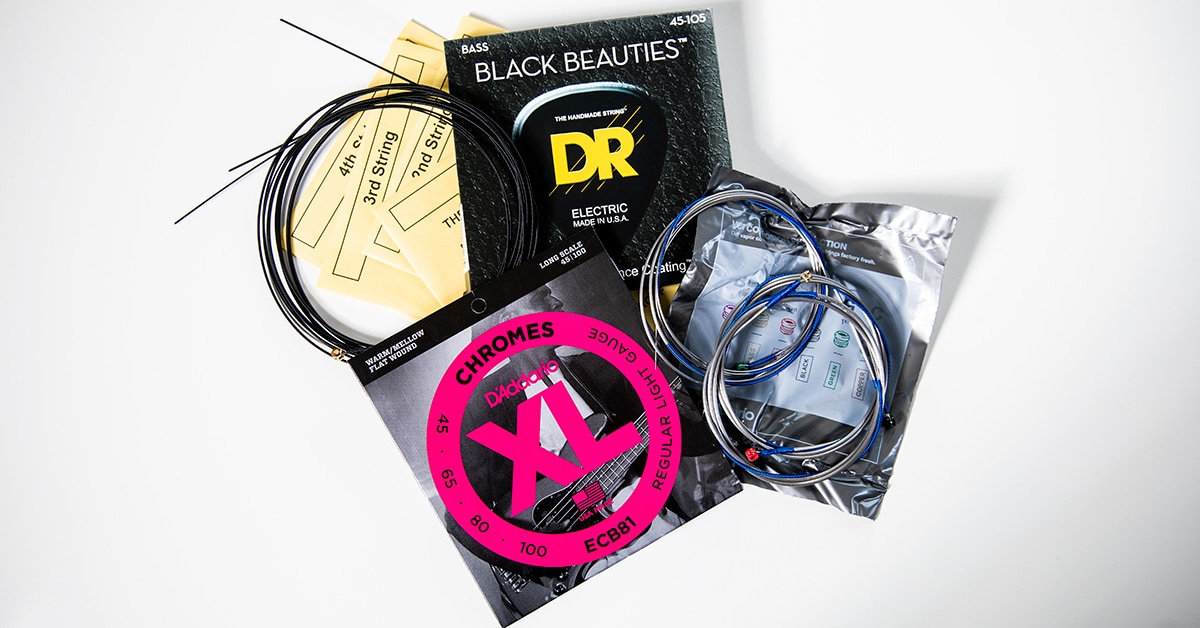Every player of stringed instruments has to deal with one cruel fact—strings are always going to need to be changed. As bass players, we may be able to go a little bit longer between sets than that crazy guitarist who puts on a fresh set of strings for every gig, but eventually, the pop and snap just go thud, and it's time. In this article, we're going to look at bass strings—how they're made, how to take care of them, when to change them and, most importantly, how to choose the best electric bass strings for you and your instrument. We'll cover the full gamut of strings—roundwound, flatwound, tapewound, halfround—and offer recommendations for different genres and playing styles from Fender, Ernie Ball, D'Addario, Elixir and other manufacturers.
If you know what type of strings you want, feel free to use the links in the handy table of contents to jump right to our recommendations. But we think it'll be worth it to look over the earlier sections, too, for some background info and tips.
Table of Contents
Some Things About Strings
When to Change Your Strings
Understanding Bass Strings
String Gauge
String Materials
Best Choices for Strings
Roundwound
Flatwound
Halfround
Tapewound
Coated/Treated
Other Scale Lengths
Extended Range
Keeping Your Strings In Shape
Conclusion
Some Things About Strings
Before we dive into specific recommendations for your best choice in bass strings, let's talk a little bit about som key factors. How often should you think about changing your strings? How are different types of electric bass strings made? What, exactly, are they made of? If nothing else, when conversation sags at a party, you can dazzle everybody with your esoteric knowledge about the subject.
When to Change Your Strings
Despite stories of legendary session players who never changed their bass strings, it's not a great idea to leave the same strings on your bass for years. While bass players can get away with much longer intervals than many other stringed instruments, we suggest that, like changing the batteries on your smoke detectors, every six months, or 150 to 200 hours of playing time, is about right. If you have sweaty hands, play aggressively or do a lot of popping and snapping, it may even be needed sooner. While you may be able to stretch that a little by taking proper care of your strings, which we cover at the end of this piece, whether you're playing regularly or not, eventually the strain of being under constant tension will fatigue your strings beyond playability.
Why do bass players tend to put off changing strings? There are a number of reasons, which may just be excuses. First, fresh strings are generally a lot brighter, and for many players, that's not a desirable sound. Second, until new strings are broken in, they feel a little stiffer and not quite as comfortable to play. Third, they feel that they just can't get "their tone" with fresh strings. We say, for the first and last, that's why your bass and your amp have tone controls. As for the second, if you're practicing enough, this shouldn't be a problem. What you really need to ask yourself, unless you've installed a countdown time on the back of your headstock, is, "How do I know when it's time to change my strings?"
There are a handful of tell-tale signs that it's time. A change in tone and sustain that keeps you from being able to play the way you want. There's also a change in feel—old strings will feel stiff in a way that's totally different from the stiffness of a fresh string. Think of it as rigor mortis. Inability to play or stay in tune and difficulty in getting harmonics can both be warning signs, as well. If you end a playing session and find that your fingertips are black or, even worse, a brownish red color, it means your bass has developed corrosion or rust problems and it's past time for a fresh set of strings.
Understanding Bass Strings
In order to pick the perfect strings for your bass, it helps to know a little about how strings are made and how those manufacturing choices affect tone, feel and overall playability. So, let's take a little side trip to the string factory.
String Gauge
Let's start off by talking about string gauge. What is it, exactly, and how does it affect your playing? In the simplest possible terms, gauge is the diameter, or thickness, of the string, expressed in thousandths of an inch. So, when you see a four-string set of bass strings that says that the gauges are from .045 to .105 (just to choose a fairly common gauge), that means the G string is 45/1000 of an inch in diameter and the E string is 105/1000 of an inch in diameter. But what, does that mean, exactly?
While regular guitar strings are composed of just a core wire and a single wrap wire, bass guitar strings are constructed somewhat differently. Each bass string is made up of a core wire, an inner wrap wire, and a reverse-wound outer wrap wire. The final string gauge is the thickness of the core wire plus twice the thickness of both the inner wrap wire and the outer wrap wire (the wrap wire encircles the core, so you always have to count it twice). Every string manufacturer has a different combination of core thickness and wrap thicknesses that can add up to the final gauge.
This difference in the gauge of the string core affects sound and feel. The heavier the string core, the higher the tension required to get a string to pitch. Changes in tension also affect the final harmonic content of a note (see more below). So, you might have a lighter core and a heavier wrap from one brand, and a heavier core and a lighter wrap from another. This is why the same gauge of strings can feel very different depending on who made it. This is also why it's important to try as many brands as you can, especially if you're looking to find the one true string that you'll play the rest of your career.
Gauge, though, is only part of the equation. What will affect your tone as much, if not more, than string gauge is string tension. Tension is where string gauge, primarily the gauge of the core wire, meets scale length. For any given scale length, the heavier the string, the more tension it takes to bring that string up to a given pitch. Higher tension generally means brighter, punchier tone and lower tension makes for a smoother tone that's slightly darker. As mentioned in the previous paragraph, that higher tension also affects the harmonic content of a note. A heavier-core, higher-tension string will produce the upper harmonic series in greater proportion. This makes individual notes richer and more "piano-like," but also means that there is more potential for harmonic clashes in chords and intervals. Deciding what the final combination of core and wrap gauges should be is a careful balancing act for the manufacturers.
Scale length also comes into play, since shorter scales require less tension to tune a given string to pitch than longer scales do. Put the same gauge strings on a short-scale base, like a Fender Mustang, and a long-scale bass, like a Fender Precision, and they will both feel and sound different, even if you have identical pickups installed. Physics can be cruel.
String Materials
Almost all strings start with the core wire, and almost all core wire is what's traditionally called "music wire" or "piano wire." While different companies will vary the gauge of their cores, and some may specify slight tweaks to the composition of the steel alloy from which the wire is drawn, this is not where the big differences lie. There are also variants in the shape of how the core wire is drawn from the carbon steel stock. While there are still a handful of manufacturers who use a traditional round core wire, most of the stock used these days has a hexagonal cross section.
Why the difference in core shape? Since it's easier for windings to slip on a round core, hex core strings have a slight advantage in longevity. The edges of a hexagonal core grip the wrap wire and help keep it in place. Round core strings require a more exacting manufacturing process, so they will tend to be a little more expensive. But, for many players, it's about the tonal differences. Hex core strings are inherently higher tension, therefore brighter, with more upper harmonics. Round core strings, with their lower tension, mellower sound and slightly slinkier feel are preferred by a number of bassists who prefer a smoother, more vintage sound.
There is also a new trend to treatment of the core wire, generally thermal treatments, like extreme cold or heat, that can affect the crystalline structure of the metal, and some players swear by these strings. Yet another reason to try a wide variety of what's available before you settle on one specific brand and gauge for your bass.
The choice of wrap wire for bass strings is where the big differences between brands and between types of strings really start to come into play. There are a wide variety of wrap wires in use—stainless steel, pure nickel, nickel-plated steel alloys, the family of nickel/copper alloys known as Monel, cobalt/iron alloys—all of which have their own sonic and magnetic properties. There are some basic generalities we can make about the tonal characteristics of the general families of wrap. Nickel, nickel alloy and nickel-plated wraps tend to sound warmer and more vintage-y. Steel wraps are brighter and crisper, making them ideal for popping, thumping funk bass and aggressive rock. Cobalt alloys have a stronger magnetic interaction with the pickups and provide higher output and a wider frequency bandwidth, for a more "hi-fi" bass tone. You can use this basic knowledge to make some initial choices about what type of string will be best for your individual playing style and preferred tone.
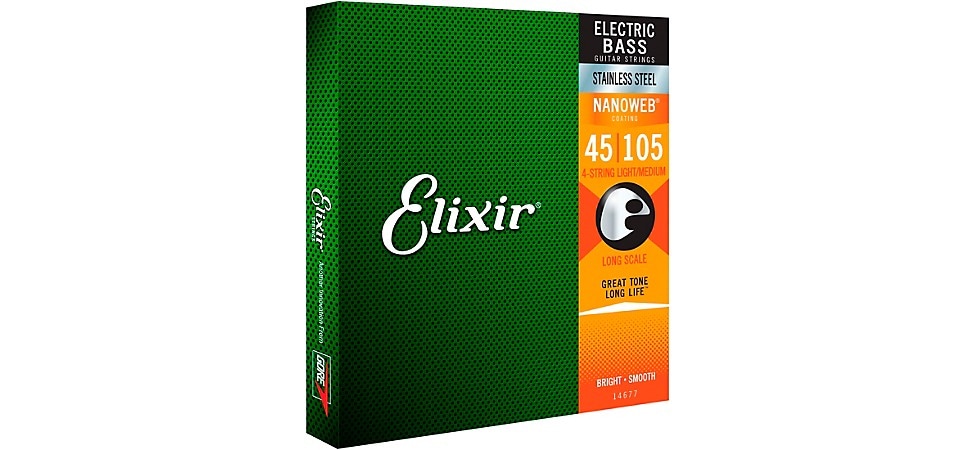
Pictured: Elixir Stainless Steel 4-String Bass Strings With NANOWEB Coating
Here are a group of recommendations based on wrap material. Bear in mind that for any of the strings presented here, they are generally available in all the popular gauges, but we're only linking to one gauge, generally the most popular for that particular set.
Stainless Steel Wrap
These will be bright and crisp, with a little extra punch in the mids
• DR Strings Fat-Beams Stainless Steel Medium 5-String Bass Strings
• Elixir Stainless Steel 4-String Bass Strings With NANOWEB Coating, Long Scale, Light/Medium
Pure Nickel Wrap
Warmer and mellower than steel wrapped, with a more vintage-style tone
• Fender 7150ML Pure Nickel Long Scale Bass Strings - Medium Light
• GHS Pure Nickel Roundwound Light
Nickel-Plated Steel Wrap
These are in between pure nickel and stainless steel, tone-wise. This makes them a good choice if you play a wider variety of genres.
• Fender 7250M Super Bass Nickel-Plated Steel Long Scale Bass Strings - Medium
• Elixir Nickel-Plated Steel 4-String Bass Strings with NANOWEB Coating, Long Scale, Light
Cobalt Wrap
As mentioned above, cobalt wraps are the most "hi-fi" with excellent response across a wider bandwidth.
• Ernie Ball 2732 Cobalt Regular Slinky Electric Bass Strings
Best Choices for Strings
The final factor in electric bass string construction leads us into where the finger meets the steel—the type of wire used in the final winding. This last layer in the string has the most influence in how it feels and a large influence on how it sounds. There are four basic variants—roundwound; halfround, which is generally a subcategory of round wounds; flatwound and tape wound. Let's look at them, one by one, with recommendations in each category.
Roundwound
Roundwound bass strings are the most popular strings for rock, pop and funk players. With their brighter sound and rich harmonic content, they tend to bring an aggressive edge to rock and accentuate the pop and snap of modern funk bass. We've got two suggestions for you here, both worthy of a try.
First, Ernie Ball 2832 Regular Slinky Roundwound bass strings. These nickel-wound, hex core strings are a perennial top-seller because they strike a nice balance between warm and bright, with enough upper harmonic content for great definition, without getting "clang-y."
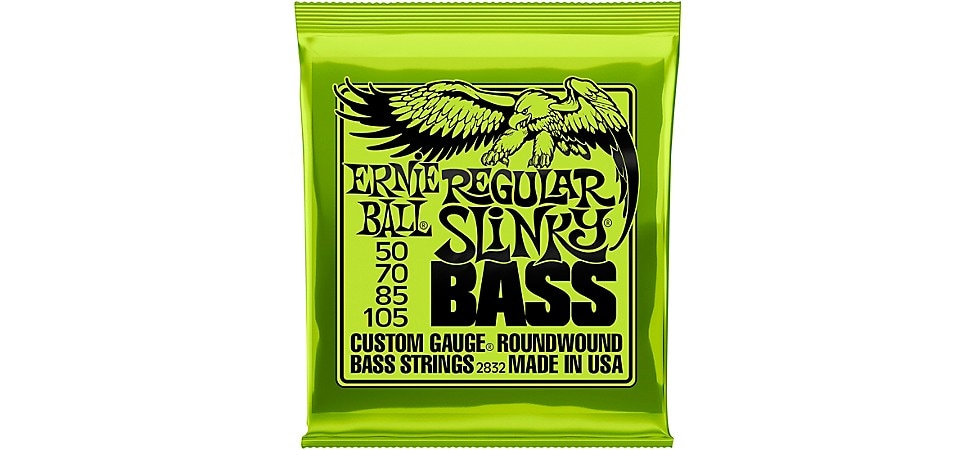
Pictured: Ernie Ball 2832 Regular Slinky Roundwound Bass Strings
Next, a round core alternative—DR Strings Hi-Beams. With an outer wrap of stainless steel to bring back upper harmonics that the inherently lower tension of a round core string loses, these bass strings are well-balanced, with a little more warmth than their hex core equivalent.
Flatwound
Flatwound bass strings have a long and storied history. Bass players like Paul McCartney and legendary Motown bassist James Jamerson used flatwounds to get their distinctive tones. Many studio players prefer flatwound bass strings for their huge reduction of finger noise. Flatwounds are mellower and warmer. The smooth feel contributes to the equally smooth tone. For old-school soul, jazz or classic country sounds, flatwounds have been the string of choice. For fretless players, they're also a great way to keep from chewing up your fingerboard. While we don't recommend never changing them, like Jamerson (who never cleaned them, either, and whose statement, "The funk is in the funk," lives on), flatwound bass strings have a generally longer life than roundwounds because of the lack of the tiny crevices between windings that accumulate dirt and grime. We present two choices here.
Our first selection is from D'Addario—ECB81 XL Chromes Flatwound bass strings. These hex core strings use a highly polished stainless steel wrap wire to keep the punch while offering the smooth feel and warm fundamentals of a flatwound bass string.
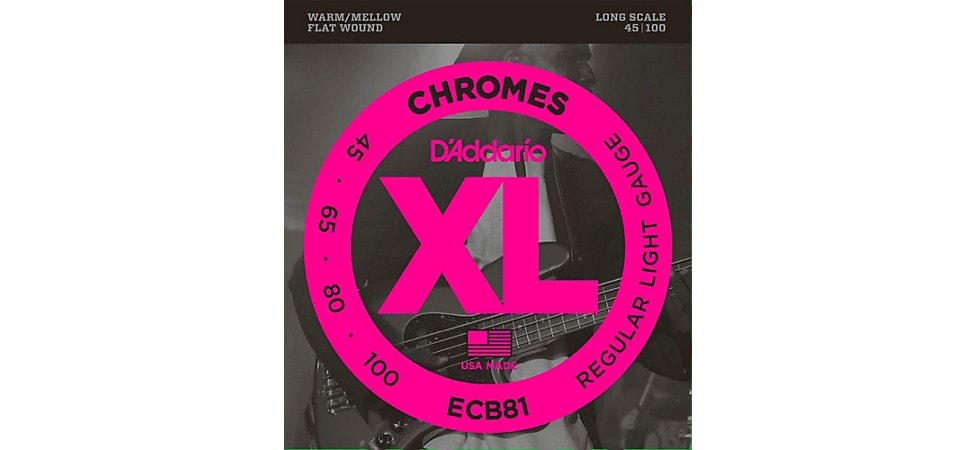
Pictured: D'Addario ECB81XL Chromes Flatwound Bass Strings
The second selection is our second round core option—DR Strings Flatwound Legend Bass Strings. Using a stainless steel wrap on flatwounds is very much a thing, as it adds to longevity, and the slinkiness of the round core construction makes these very easy to play, with a well-balanced warmth.
Halfround
Finding a space between the feel and tone of roundwound and flatwound strings are halfround strings. There are two ways of producing these strings. First, a wrap that's round on one side and flat on the other, wound with the flat side out. Second, a fully round wrap that's then ground down to flat. Either way, the feel and reduced finger noise are close to flatwound strings, but the overall tone is brighter and closer to roundwound bass strings. For players who want that brighter punch but still want the feel of flat, we've got one recommendation here.
D'Addario ENR71 Half Rounds Light bass strings fall into the category of what are sometimes called "half-ground" strings, with two steps in the wrap process—making an oversized roundwound string, then grinding down the outer winding to flat. Not quite as bright as a fresh set of roundwounds, but about the equivalent of a roundwound set that's been on the bass for a month or so, you'll find that their tone lasts substantially longer, thanks to the highly polished flatness of the outer wrap not collecting debris. Keep 'em clean, and they'll maintain tone a good long while.
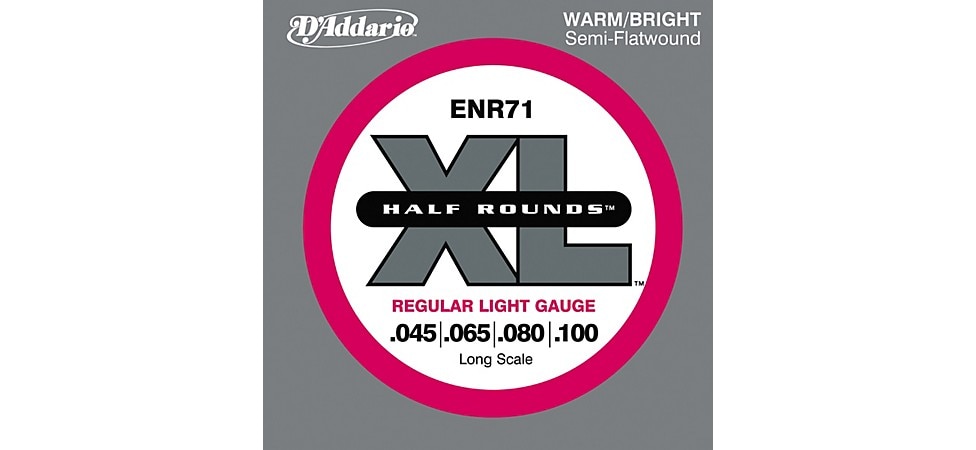
Pictured: D'Addario ENR71 Half Rounds Light Bass Strings
Tapewound
A style of string that has come and gone in general fashion, but has maintained a loyal following of players over the years, tapewound strings are the mellowest of all bass strings. For these strings, the outer wrap is a flat nylon tape, frequently polished to a silk-like finish. The tone on electric bass is very similar to the tone of an acoustic double bass. In fact, the preferred string of many acoustic bassists who double on electric are a set of tapewound strings. Warm and full, these don't carry a lot of sustain, but have immense body to the sound. Jazz, reggae, even many contemporary alternative players have been adopting tapewound bass strings, either on their primary instrument or on a secondary bass for exactly that tonal quality.
Our choice here is the D'Addario ETB92 Nylon Tapewound Medium Gauge bass strings. With the nylon tape wrapping polished as smooth as the tones you'll get out of these, they're a wonderful first step into the world of mellow tone.
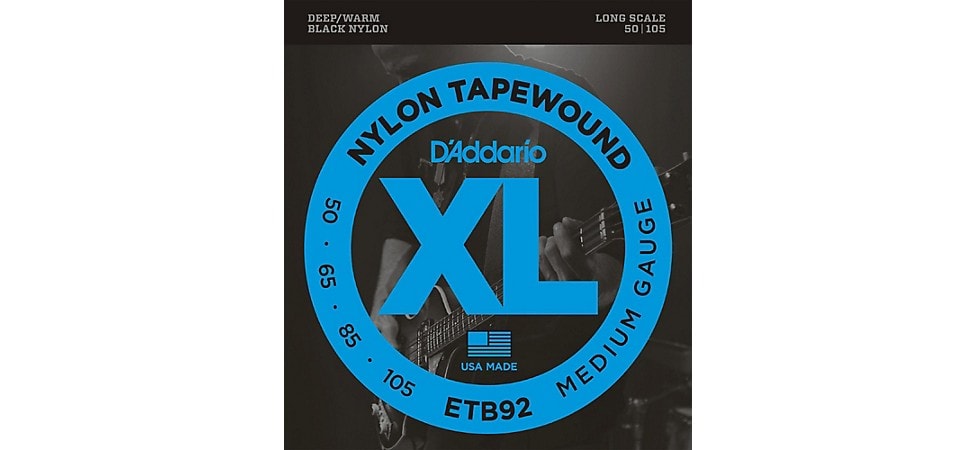
Pictured: D'Addario ETB92 Nylon Tapewound Medium Gauge Bass Strings
Coated/Treated
Over the past couple of decades, new varieties of string have emerged. Strings with specialized coatings or special treatments that lengthen string life and/or enhance tonal characters are available from a number of companies. We touched on string treatments in the section on string materials above. Here we'll take a look at string coatings and their strengths and weaknesses.
The primary strength of using a thin, and we mean very, very thin, coating on strings is that it substantially increases the longevity of the string. As a side effect of this, resistance to breakage is also increased. These coatings, generally much less than the thickness of a human hair, keep dust, grime, skin cells from your fingertips, moisture and other materials that could corrode the wrap or the core from accumulating. Coated strings that are cleaned after every use can, in theory, last until the metal fatigues from being under constant tension. The biggest downside to coated strings is that they are perceived to sound dull, compared to uncoated strings. We use the word "perceived" for a reason. Brand-new, uncoated strings, by the time they're properly stretched out and settled in, say a day or two, will sound duller than they did when you first put them on the instrument. In fact, they'll sound just about as bright as the coated strings at that point. The coated strings will maintain that level of tone for a much longer period than uncoated strings will. This leads to our belief that, since many bass players prefer the sound of strings that have been slightly broken in over the tone of absolutely fresh strings, there's no real downside to coated, other than initial perception. On the other hand, if you change your bass strings every week because you love that super-crisp twang of fresh roundwounds, coated strings may not be for you.
We've got three choices here. All three are five-string sets, but if you're a four-string player, you can find those sets as well.
First, D'Addario XT Coated Nickel 5-String Regular Light Long Scale are a nickel coated hex core set that have the appearance of regular uncoated strings, with the longevity of coated ones.
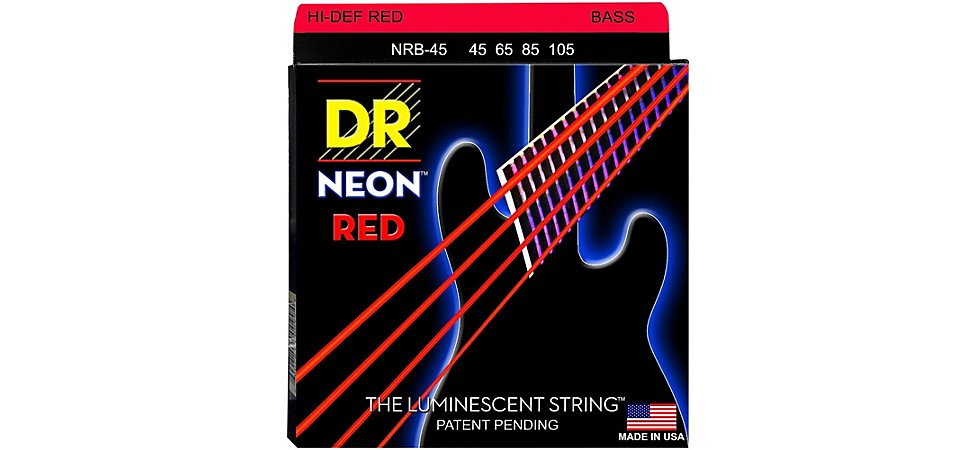
Pictured: DR Strings Hi-Def NEON Red Coated Medium Bass Guitar Strings
The next two sets are both from DR—Hi-Def NEON Red Coated and Black Beauties Black Coated both in medium gauge. These strings take advantage of the fact that a string coating doesn't have to be clear and offer a chance to tweak your visuals to match your personal style.
Other Scale Lengths
Short-scale basses like the Fender Mustang, Gibson SG and Hofner "Violin" bass have been regaining popularity both for the unique tonal qualities that come from lower tension and from the change in harmonic emphasis a shorter scale creates. Many bassists, taking inspiration from short-scale players like Jack Bruce, Paul McCartney, Stanley Clarke, Sonic Youth's Kim Gordon and Talking Heads' Tina Weymouth, have picked up short-scale instruments. Short-scale basses are also a popular starting point for guitarists who are looking to double on bass.
Our first of two recommendations are the D'Addario EXL220S XL Nickel Super Light Short Scale strings. These hex core, nickel-wrap roundwounds super-light gauging offer a slinky, easily bendable twist to the warm, vibrant short-scale tonal world.
Our second choice, the DR Strings HI-BEAMS Short Scale 4-String Medium strings are a round core option. Offering a little more tonal beef than the first choice, but still an easy feel, thanks to round core's basic lower tension, you'll get a little higher output and just a hair more highs.
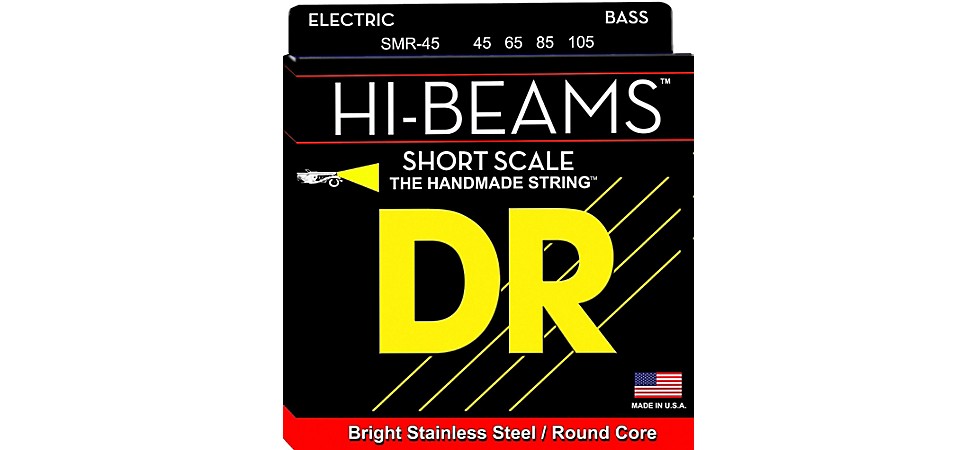
Pictured: DR Strings HI BEAMS Short Scale 4 String Bass Medium
For extra-long (35"+) scale basses, the attraction is the extra upper harmonic content that comes from the higher tension required to bring the string to pitch and the ability to downtune without the strings getting exceedingly floppy. Five- and six-string electric basses are often longer scale, but we'll talk about them in the next section.
We've got a pair of choices for you in this scale length. First, the Elixir Nickel-Plated Steel with NANOWEB Coating Extra-Long Scale strings bring the advantages of coated strings to an extra-long scale. Expect crisp, piano-like tone with rich upper harmonics if you tune these to standard pitch, and some serious low-end punch if you downtune.
Next, the Dunlop DBN45125XL Bass-NKL 45/125 Extra-Long Scale 5-String set is a nickel-wrap set that add a slight touch of warmth to the punch and upper richness of an extra-long scale instrument.
Extended Range
Our last stop is the world of extended-range, five- and six-string electric basses. The move towards adding an extra string or two have been growing across genres. From metal to contemporary gospel, jazz to blues, that added impact of a five-string's low B and the improvisational freedom that's added in the upper range with a high C on a six-string have seriously expanded the role of modern bassists.
Aside from the number of strings, there are also multi-scale basses, as from Strandberg, Ibanez and others, which use the tension and tonal variations of multiple scale lengths to create a balance between harmonic content, punch and playability. The sets we'll list here should apply to all extended-range basses.
For five-string basses, we already mentioned the DR Strings Black Beauties in the section on coated strings. To those, we're adding the D'Addario EXL170-5 XL Nickel Round set as a non-coated option. Bright and punchy, with a strong attack but a hint of nickel warmth, these are a great choice for modern funk, gospel and metal players.
For six-string players, we've got a pair of choices, one specifically made for the original six-string bass, and the other for more contemporary six-strings. First, LaBella 767-6F Flat Wound 6-String Bass VI strings were designed for the Fender VI, which was, to our knowledge, the first commercially available six-string. Tuned like a regular guitar, only an octave down, this was a favorite among studio players and producers for surf and spaghetti western movie soundtracks, and has had a modern resurgence thanks to reissues and retro-modern musicians.

Pictured: LaBella 767-6F Flat Wound 6-String Bass VI Strings
Second, for players with a more modern bent, are the D'Addario ProSteels EPS170-6 Regular Light 6-String bass strings. ProSteels feature a stainless steel wrap which both enhances magnetic interaction for more output and generates more and stronger highs. From serious punch on the low B to a singing high end that cuts through in the upper register, these will keep your six-string electric bass where it needs to be in the mix.
Keeping Your Strings In Shape
Now that you've got your new strings on your bass, the next question is, "What can you do to make sure they stay sounding great for as long as possible?" We'd like to pass along a few tips and some advice.
First, learn proper stringing technique for the type of tuners, bridge and bass you've got. And for the type of strings, too. For example, round core bass strings on thru-post tuners will give best results if the string end is securely locked under the first wind around the tuner post, and not cut until after they're on, tuned and have been properly stretched out. On split-post tuners, like vintage-style Fenders, make the 90° bend to insert into the tuner post before you cut off the excess string, not after. This is actually a good practice for both hex core and round core strings. If you're uncomfortable doing a restring, take your bass by your local Guitar Center and the Repairs techs will be glad to help out. If you're doing it yourself, make sure that you have a good pair of string cutters and a string winder, just to make it clean and save some time.
Keeping your strings and fretboard clean will go a long way towards helping your strings achieve their maximum lifespan. Grab a box of string wipes and a microfiber cloth. Use the cloth to do a quick wipe down of the strings after every playing or practice session and use the wipes to give the strings a thorough cleaning at least once a week. Clean your fingerboard regularly, too, so there's less possibility for the grunge that collects there to find its way between your string windings. If your fingerboard is rosewood, pau ferro or any other unfinished dark wood, grab a bottle of fretboard conditioner too, to keep it properly moisturized and clean. A finished maple fingerboard doesn't need the conditioner, just a good wipe down and a regular polish with the same light polish you use to keep that bass nice and shiny.
Conclusion
There you have it—everything you need to make a smart choice about bass strings. Or at least, it should be, but an article like this can't answer questions that are more specific to your personal needs. So, if you think of a question that's not answered here, please feel free to ask one of our knowledgeable associates, either at your local Guitar Center, or at our Call Center. They'll be glad to help you figure out what strings will be best for your specific combination of bass, personal playing style and the genres of music you love to play.
.jpeg)






